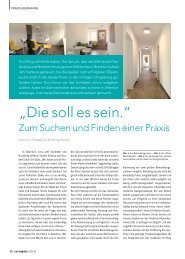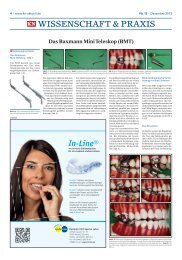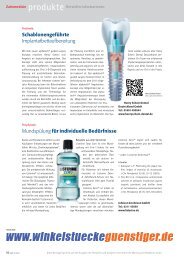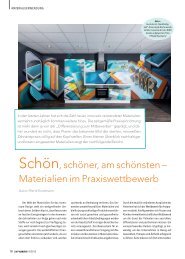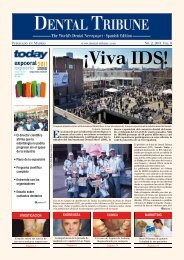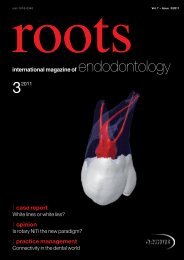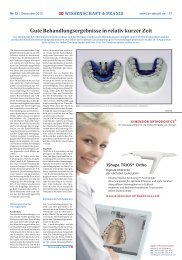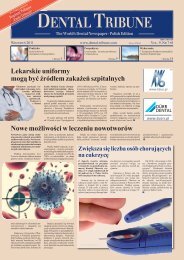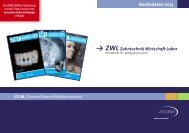Download - Oemus Media AG
Download - Oemus Media AG
Download - Oemus Media AG
Create successful ePaper yourself
Turn your PDF publications into a flip-book with our unique Google optimized e-Paper software.
DeNtal tribuNe | april-June, 2010 trends & applications 27<br />
correctional appliances—irrespective<br />
of whether these use<br />
the Herbst splint or canted<br />
plane principle—have the same<br />
problem and the same undesirable<br />
side effects. There is a<br />
risk of protrusion of the lower<br />
frontal teeth and/or distalisation<br />
of the upper molars. By means<br />
of passive stabilisation with<br />
the aid of two miniscrews<br />
(Figs. 7 and 8), these effects<br />
can be readily avoided.<br />
the dental ridge (Fig. 10b).<br />
There should be at least<br />
1 mm of bone to the mesial<br />
and distal sides of the mini -<br />
screw. The hole for the insertion<br />
of a miniscrew (1.6 mm) should<br />
thus be at least 2.6 mm. A provisional<br />
crown can then be<br />
mount ed onto the head of the<br />
mini screw. If necessary, a<br />
bracket can be fixed to this<br />
crown (Fig. 10c).<br />
Outlook<br />
The clinical use of mini screws<br />
supports a wide range of tasks.<br />
Dental repositioning that was<br />
previously deemed impossible<br />
becomes achievable, whilst<br />
possible repositioning techniques<br />
are improved and supported.<br />
In order to achieve<br />
this, miniscrews alone are not<br />
sufficient; an appropriate range<br />
of equipment is also necessary.<br />
Several suppliers of miniscrews<br />
offer, in addition to<br />
screws and insertion tools, a<br />
number of devices that facilitate<br />
the use of miniscrews. The<br />
fifth part of this series will<br />
focus on the wide range of<br />
useful auxiliaries that are<br />
available.<br />
DT<br />
About the author<br />
Dr. Björn Ludwig<br />
Am Bahnhof 54<br />
56841 Traben-Trarbach,<br />
Germany<br />
Tel.: +49 65 41 81 83 81<br />
Fax: +49 65 41 81 83 94<br />
E-mail: bludwig@<br />
kieferorthopaedie-mosel.de<br />
Editorial Note: The next edition<br />
of Dental Tribune India will<br />
feature part V of this article.<br />
Orthognathic surgery<br />
After surgical intervention<br />
to relocate or reposition the<br />
jaw (for orthodontic or traumatological<br />
reasons), it is important<br />
to maintain a stable correlation<br />
between bone fragments<br />
and the jaw in the postoperative<br />
phase. This promotes healing<br />
and prevents relapse. The<br />
occlusion appliance is fixed<br />
intraorally, using intermaxilliary<br />
elastic or wire ligatures,<br />
depending on the situation.<br />
It is essential to use the appropriate<br />
fixing options, whether<br />
this is a splint (Schuchardt<br />
splint) or a multi-bracket appliance.<br />
Where these are really<br />
only needed in one jaw or jaw<br />
section, the question arises<br />
of whether, in the era of<br />
the miniscrew, it is necessary<br />
to involve the other jaw in<br />
the stabilisation of the surgical<br />
effect. If miniscrews are used<br />
in the opposing jaw (Fig. 9),<br />
the same effect is achieved—<br />
but with considerably less<br />
restriction from the point<br />
of view of the patient.<br />
Pre-prosthetics<br />
It is the aim of pre-prosthetic<br />
orthodontics to position the<br />
teeth optimally for the subsequent<br />
prosthesis. This can<br />
include intrusion, uprighting,<br />
and the opening or closing<br />
of gaps, amongst other techniques.<br />
As this series and many<br />
other publications have already<br />
shown, miniscrews are particularly<br />
useful in this context.<br />
Mini screws can also be used<br />
as anchoring elements for<br />
a provisional prosthesis. Where<br />
teeth are missing (particularly<br />
the second canines, Fig. 10a)<br />
and the growth phase is not<br />
yet completed, the fitting<br />
of an intermediate prosthesis<br />
is problematic. As an alternative,<br />
particularly where additional<br />
anchorage is required,<br />
miniscrews can be used. A<br />
longer screw (8 or 10 mm) can<br />
be inserted in the centre of



